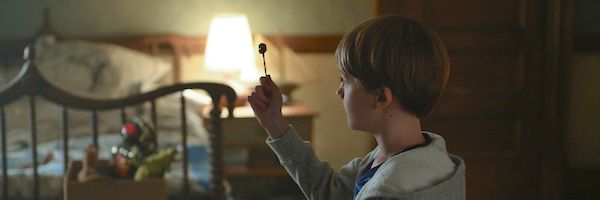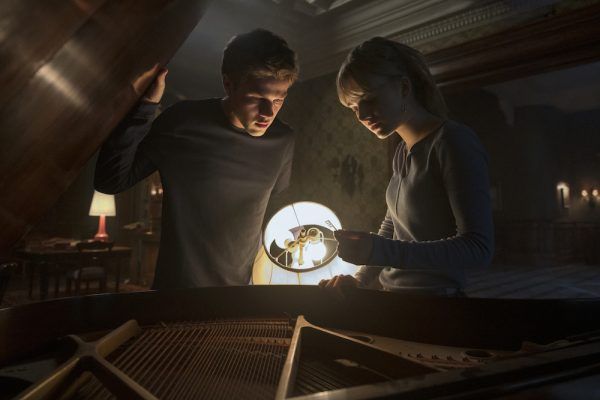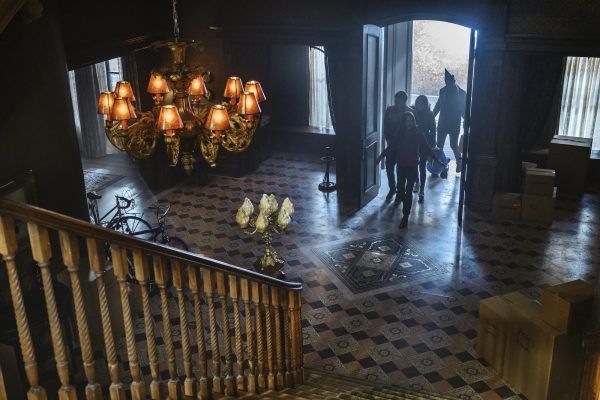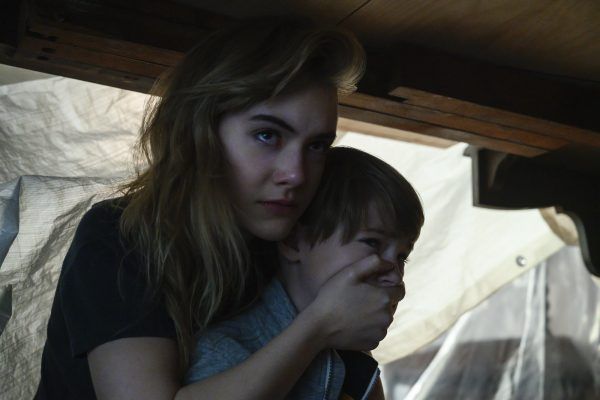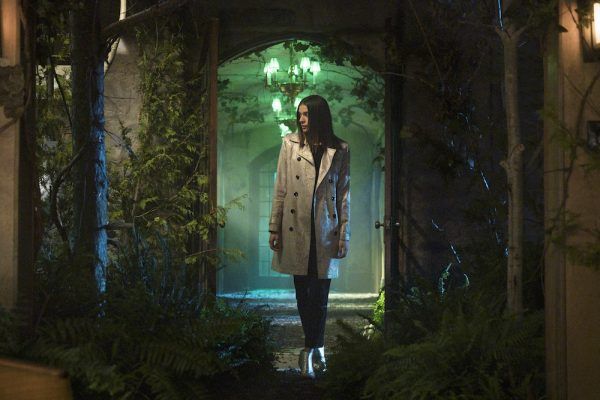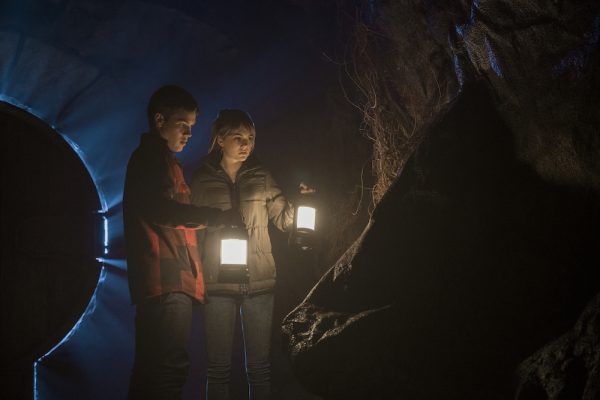From co-showrunners Carlton Cuse (Bates Motel, Lost) and Meredith Averill (The Haunting of Hill House), and adapted from the best-selling comic book series by Joe Hill and Gabriel Rodríguez, the Netflix original series Locke & Key follows the Locke family, as they move to their ancestral home, Keyhouse, after their father is murdered under mysterious circumstances. Once there, while learning to deal with the grief that they are experiencing, they discover that the house is full of magical keys, each with their own unique powers, and that there’s a demon who will stop at nothing to get its hands on them. The series stars Darby Stanchfield (“Nina Locke”), Connor Jessup (“Tyler Locke”), Emilia Jones (“Kinsey Locke”), Jackson Robert Scott (“Bode Locke”), Bill Heck (“Rendell Locke”), Laysla De Oliveira (“Dodge”) and Sherri Saum (“Ellie Whedon”).
During this phone interview with Collider, executive producers/writers Carlton Cuse and Meredith Averill talked about the long journey in getting this project to the screen, why Netflix was finally the right home for Locke & Key, how The Haunting of Hill House informed Keyhouse, making the keys, putting this cast together, their experience collaborating with Joe Hill, lining up the directors, the biggest production challenges, and how far along they already are on Season 2.
Collider: First, I have to say that I’ve been waiting for this TV series for a long time. I saw the 2011 Fox pilot, and then waited through possible movies, and a TV series that didn’t happen at Hulu, before this series now hitting Netflix. I’m just thrilled that it’s finally coming out.
CARLTON CUSE: I’m amazed that you picked up and started following this when you were in pre-school.
Carlton, since you’ve been developing this for awhile yourself, at Hulu and then at Netflix, why do you think it’s had such a long journey to the screen, and what was it that spoke to you deeply enough that you’ve been through two networks on it?
CUSE: There are just certain things that you fall in love with. Particularly the farther I get into my career, the more I really just make emotional decisions about what it is that I wanna do, at that time, in terms of stories. The comic came out in 2008, and I read it back then and just loved it. I thought it was a really rare and special comic because it was genre, but it was deeply emotional, and it also felt fresh and special. It didn’t feel derivative of a lot of other things, which is really hard to say, when you’re dealing with a haunted/fantasy house. And then, the project was tied up with other people, from Steven Spielberg to Alex Kurtzman. Circumstantially, a few years ago, I was having a meeting with my agent about something else and he said that, afterwards, he was going to have a meeting about Locke & Key. I said, “That’s available?” And he said, “Yeah, the rights have reverted back to Joe Hill.” I said that I loved it, and that got communicated back to Joe Hill, who was a fan of stuff that I’d done. So, we connected and started working on it, and began a long and winding road to get to the screen.
All along the way, I kept trying to figure out what was important and what lessons could be learned from the bumps in the road. And then, we sold the show to Netflix, and very luckily and happily for me, connected with (co-showrunner) Meredith [Averill]. We really had such a common vision of what we needed to do to make the show work. Netflix was interested in leaning into the fantasy element of the show, in a way that was much truer to the comic. We took this shared vision and went to work, and finally managed to figure out how to put all of these elements that are in this comic together, in the right cocktail. Part of the challenge was that there’s so many different things going on, from horror to fantasy to family drama, and there’s a murderer and teen drama. Figuring out how to proportion all of those things out in a way that makes logical sense and feels cohesive was really hard. It took us awhile, but I think we’re both really proud of the final result.
You’ve both come from series where houses feel like such a huge part of the story you were telling, whether it’s Bates Motel of The Haunting of Hill House, and now you’re doing it again, with this show. Did that help inform the way you approached the design of Keyhouse?
AVERILL: Yeah, absolutely! Hill House was always part of the conversation, in that we didn’t want Keyhouse to feel like Hill House. We wanted Keyhouse to feel warm and inviting and whimsical, and like a place that you might want to Airbnb, whereas Hill House, in keeping with the tone of that show, was much darker and colder. So, there were constant conversations with our production designer, Rory Cheyne, about how we might find that warmth in Keyhouse, and we think he did such an incredible job. There’s a real attention to detail, throughout that house. In the wood panels, you’ll find little KHs. There are Easter eggs hidden throughout the house, for the comic book fans. Even the wallpaper in Kinsey’s room looks vaguely like a key. Rory really did a tremendous job, in helping to make the house feel like its own character.
The keys also play such an important role in this. What was it like to actually get the keys made, and to have such an important physical and tangible element of the story?
CUSE: Fortunately, we had a really great guide, which was that Gabriel Rodríguez had drawn a lot of the keys in the comic and had done a really brilliant job of conceptualizing them. Even though we invented a couple of keys that weren’t in there, his design basis became the template for how we would do them. And then, on top of that, we had a really great prop master and production designer, and we just kept doing iterations. We’d be sitting around Toronto, and they would bring them in and we would give notes, and then they would go back and revise them. We spent a lot of time working on them because the show is called Locke & Key. We wanted to be sure that all of the keys were really well-conceived and cool.
AVERILL: We hope that, by this time next year, everyone will want their own collectible keys.
Was there ever a time when somebody thought they’d lost a key and there was a moment of panic?
AVERILL: I don’t think so. We had a pretty incredible prop master, that would never let that happen, unless there was a demon walking amongst our crew that might be trying to steal keys. Thankfully, our prop master was pretty on top of it.
CUSE: The keys were kept under lock and key. They were never floating around. They’d come out, be used for a scene, and then be taken away.
AVERILL: They were treated like they were a prized possession.
With the casting for this, it must have been so important to have that family dynamic. This is a family that makes mistakes and they all screw up in their own way, but you can tell that they really love and care about each other. Did you have a moment in the casting process, after getting everybody together, when you realized that was really working?
AVERILL: Yeah, I can absolutely remember a moment, sitting at our table read for the pilot in Toronto, and the actors met, for the very first time. They were all sitting in a row, and just sitting there watching them recite their lines, we all could feel it in the room, that there was this immediate chemistry between them. Over the course of the six months that we worked on the show, they became very, very close. It’s nice that the chemistry is not just onscreen, it’s also off screen. I think you really feel that, when you watch the show.
When it came to casting and character like Dodge, what were you looking for and how did you want to bring that character to life?
CUSE: Joe Hill had written the pilot script, and it was a really challenging part to cast because that actor has to be charming, super-intelligent, devious, manipulative, malevolent and sexy. She needed to be everything, so we really looked a lot of different actors and finally found Laysla [De Oliveira], who was awesome. It was hard. We felt it was a high bar. We recognize that most stories are only as good as the antagonist, so we worked hard and it took a lot of effort to find the right person.
What’s it been like to work with and collaborate with Joe Hill, for this series? Were there things that he gave you a specific insight on, that really helped make everything work?
AVERILL: It’s been great to use him as a resource because he has an encyclopedic knowledge of that world and he just knows it so well. We can call him and ask him a question like, so how are keys made? And he doesn’t even have to think about the answer. He just knows the answer, so intuitively. That’s just one example. When we’ve reached out to him with questions like that, he just has this great encyclopedic knowledge of that world.
With a show like this, it seems like it’s very important, who you pick to direct the episodes, especially in the beginning, to set up the series. What was your process like, for deciding who would direct each episode, especially when it came to the first couple of episodes?
AVERILL: We had met with our director who directed the pilot and Episode 2, Michael Morris, pretty early on, and he just came in with such a specific imaginative vision for what this world might look like. He had an incredible look book that was very much in line with the show that Carlton and I had in our heads, as well. We just felt that we were on the same page, and also that he had added elements to it that really elevated it and made it feel specific and whimsical. So, we knew, right away, that we were very much aligned, creatively, with him. And throughout the process of his directing of those two episodes, he was such a great collaborator with so many exciting ideas for ways that he wanted to shoot things. He was a terrific partner for us, early on.
What would you say the biggest challenges were, in figuring out how to adapt this, from page to screen? Was there anything that you wanted to do, visually, that just was really hard to figure out how to bring to life?
CUSE: There was a lot, especially the Head Key. In the comic, there are splash panels, where the characters heads literally tilt open and you can see inside their brain, and that did not seem like it was gonna translate very well to television. So, Meredith and I had to reconceive how to metaphorically take a journey through someone’s head and figure out how to do that, in a way that we could actually pull off, on a television schedule and budget, with visual effects. We thought it was a fun challenge to figure out, given what we know about each of these characters, what would the inside of their heads look like? That turned out to be really just a fun, creative process of trying to imagine what the environment would be for each character, if we went inside their head.
This season does not wrap things up with a neat little bow. There are definitely many questions and much more story to tell. Have you guys thought about the story that you want to continue to tell and what Season 2 would look like?
CUSE: Yeah. Although Netflix has not picked up Season 2 (at the time this interview was conducted in January 2020), and their policy is not to do that until they have 30 days of data on the show, they have paid for a writers’ room. We’re in the middle of writing Season 2, so we’re optimistic and hopeful that we’re gonna get a chance to make Season 2. We very much know what it is because Meredith and I are in the middle of overseeing the writers’ room and we’re working on that right now.
Does it feel like there’s a little bit more of a sense of freedom, in what you can do and what you’re can explore, if you’re not quite following the comics?
AVERILL: There certainly is more room in Season 2 for new stories, but we’re also always still mining story from the comics. There definitely are stories left in the comics that we want to hold onto, to use in future seasons. So, it still remains a bit of a remix, of pulling from stories from the comic and our own original stories.
When you approach the writing of a season, whether it was when you were doing the first season or now that you’re doing the second season, at the same time that you’re working on that season, are you also thinking about how to weave in things that you can follow up, down the road?
CUSE: There was a story process that we went through, which was, there’s so much great stuff in the comic and we had to make some fundamental decisions about what we were gonna put in Season 1 and what we were gonna push down the road to Season 2. We spent a lot of time talking about how far we wanted to advance the audience’s knowledge of the mythology in the first season, and we made some very conscious decisions about what we wanted the audience to know by the end of the first season and what we were gonna hold for the second season. I think we’re pretty happy with the results. There are still some cool revelations in Season 2, but we wanted to give the audience a good dose of answers in Season 1.
Locke & Key is available to stream at Netflix on February 7th.

